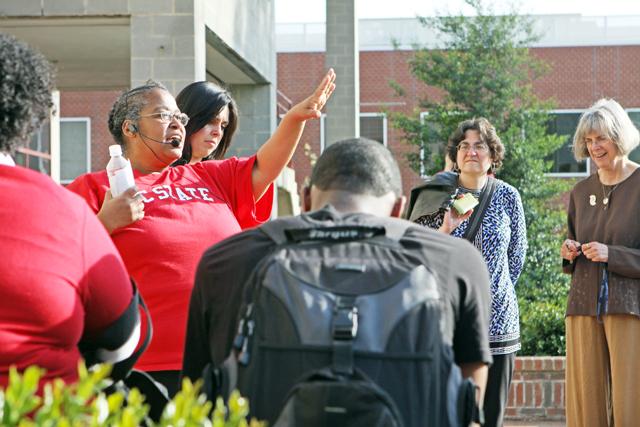
Emily White
There was a time when the University typically shunned African-American students.
To be accepted at N.C. State, they had to be in-state residents, and could be admitted only if the courses they wanted to graduate in were not offered in traditional black universities like Central and A&T.
That was then, in times when race-directed campus violence was a common occurrence across the nation, and now, N.C. State graduates more African-American students than does any historically black university in the entire UNC system.
Speaking on the occasion of the inaugural “Red, White and Black” tour, Walter Jackson, associate professor in history, shared similar historical facts about the University’s African-American student population.
For instance, the West Dunn building was the first unofficial African-American Cultural Center, and the first four African-American students were admitted not until 1956.
The tour started from the D.H. Hill library, and Jackson walked students and other attendees across campus, stopping at Holladay Hall, Stewart Theater and Watauga Hall before arriving at the African American Cultural Center in Witherspoon Student Center.
Jackson said he became interested about African-American history while teaching a course on civil rights history.
“When I was teaching that course, my students read about violence on campus that was prevalent during those times,” Jackson said, “They asked me about the situation at N.C. State and I didn’t know anything about it. So that was when I started learning about it, about 10 years ago.”
The tour was the brainchild of Toni Thorpe, program coordinator at the African American Cultural Centre, who said she got the idea of organizing the tour last fall.
“Serving on the 50th anniversary commemoration of African-American students on campus helped me to learn about their presence,” Thorpe said, “and last fall I got this idea for the tour that we organized today.”
Thorpe said she wants to institutionalize the history of these students at N.C. State, and this tour is a step forward towards that end.
“When you look at the history of anything, nothing stands independent as an isle, so you have to institutionalize things,” she said, “we are talking about institutionalizing these students’ voices historically at N.C. State.”
Thorpe shared this idea with the Libraries, and they were only too glad to help. The tour and Jackson’s speech was full of information the Libraries had found sifting through the archives.
According to Marian Fragola, director of programs, planning and outreach with the Libraries, the tour was a result of cooperation between D.H. Hill and the AACC.
“We had been planning about this since last fall, so this has been a long time in the making,” Fragola said, “We looked into our archives and helped the AACC find relevant material. Though we don’t have much scholarly work, but a lot of other material, like the letters from previous chancellors where we got some of the information used in the tour.”
The tour is not just a one-off initiative in this direction for the Libraries, according to Fragola.
“We’re planning to incorporate this information on a mobile app, and it will be much like the current WolfWalk app,” she said, “users will be able to learn more about spots on campus that have a history related to African-American students.”
Thorpe, for her part, is excited about making the tour an annual event at the University.
“We are thinking of making this an annual event in the future,” Thorpe said, “We could have it in the beginning of the year before the traditional time for harvest, called harambe.”
Harambe literally translates to ‘let us come together’ in Swahili, according to Thorpe.
The event was attended by students and University officials alike, including Evelyn Reimann and Tim Luckadoo, both associate vice chancellors for student affairs.
Also in attendance was Sheila Smith-McKoy, head of the AACC.
Smith-McKoy, an alum of N.C. State said she learnt a lot from the event.
”I learnt a lot about African-American history at N.C. State myself today,” she said, “we’re grateful for the libraries for helping us with this.”
Many students attended the tour, and found the historical perspective on the issue to be very interesting.
Chris Broadhurst, a doctoral student in higher education administration liked what Jackson talked about on violence on campus.
“The event taught about the hostility towards African-americans in Universities in general, and how N.C. State avoided racial tensions versus other campuses,” he said, “the stories they were telling about during the tour were very informative and interesting.”
DeShawn Brown, a freshman in mechanical engineering was also interested to learn about the history of such issues on campus, and how it is shaping his experience on campus today.
“N.C. State has had a lot less violence than other schools and it was very interesting to learn about the history at N.C. State, especially because it is not very well known and not well advertised,” Brown said, “For me being an African-American, it was nice to learn how the first students here felt and what they went through. They were very brave, and they paved the pave for us.”
Brown is optimistic that despite the past events, the University is doing a good job of creating a positive environment.
“We’re far from perfect, but I think the University does a good job of creating an environment where people of different backgrounds can feel accepted. I know that I certainly feel accepted,” Brown said, “I certainly think they should continue with such events and teach us more about African-American history.”